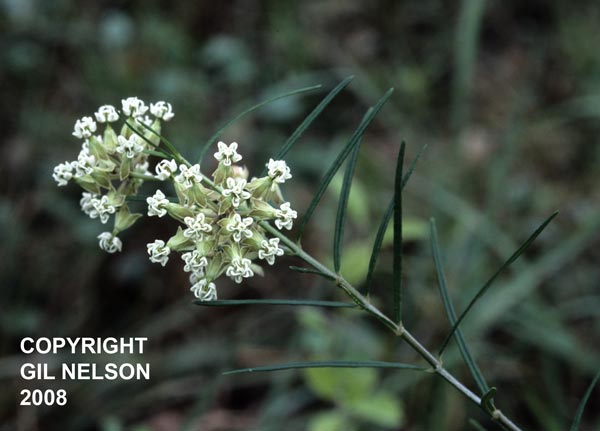Difference between revisions of "Asclepias verticillata"
| Line 22: | Line 22: | ||
==Ecology== | ==Ecology== | ||
===Habitat=== <!--Natural communities, human disturbed habitats, topography, hydrology, soils, light, fire regime requirements for removal of competition, etc.--> | ===Habitat=== <!--Natural communities, human disturbed habitats, topography, hydrology, soils, light, fire regime requirements for removal of competition, etc.--> | ||
| + | Native upland pine and pine-hardwood communities, loblolly pine plantations (Ultisols), borders of wetland depressions within pine communities, sandhills and sand ridges, (Entisols), open calcareous glades, bluffs along Apalachicola River (FSU Herbarium). It can be found in bluestem prairie (Hover and Bragg 1981). It increases with spring burning (Hover and Bragg 1981). It is a warm-season grass (Hover and Bragg 1981). Can occur in areas with soil disturbance (FSU Herbarium). Thrives in frequently burned areas and flowers within two months of burning in the growing season (Robertson observation). Tolerates full sunlight to partial shade. Tolerates moist to xeric conditions but seems to be limited to sandy or calcareous soil. | ||
===Phenology=== <!--Timing off flowering, fruiting, seed dispersal, and environmental triggers. Cite PanFlora website if appropriate: http://www.gilnelson.com/PanFlora/ --> | ===Phenology=== <!--Timing off flowering, fruiting, seed dispersal, and environmental triggers. Cite PanFlora website if appropriate: http://www.gilnelson.com/PanFlora/ --> | ||
| + | Flowers and fruits from April to September (FSU Herbarium). Flowering appears to be stimulated by fire. | ||
===Seed dispersal=== | ===Seed dispersal=== | ||
===Seed bank and germination=== | ===Seed bank and germination=== | ||
| Line 33: | Line 35: | ||
==Photo Gallery== | ==Photo Gallery== | ||
==References and notes== | ==References and notes== | ||
| + | FSU herbarium herbarium.bio.fsu.edu | ||
| + | |||
| + | [[KMR]] | ||
| + | |||
| + | Hover, E. I. and T. B. Bragg (1981). "Effect of season of burning and mowing on an eastern Nebraska Stipa-Andropogon prairie." American Midland Naturalist 105: 13-18. | ||
Revision as of 13:43, 26 June 2015
| Asclepias verticillata | |
|---|---|

| |
| photo by Gil Nelson | |
| Scientific classification | |
| Kingdom: | Plantae |
| Division: | Magnoliophyta - Flowering plants |
| Class: | Magnoliopsida - Dicotyledons |
| Order: | Gentianales |
| Family: | Asclepiadaceae |
| Genus: | Asclepias |
| Species: | A. verticillata |
| Binomial name | |
| Asclepias verticillata L. | |

| |
| Natural range of Asclepias verticillata from USDA NRCS Plants Database. | |
Contents
Description
Distribution
Ecology
Habitat
Native upland pine and pine-hardwood communities, loblolly pine plantations (Ultisols), borders of wetland depressions within pine communities, sandhills and sand ridges, (Entisols), open calcareous glades, bluffs along Apalachicola River (FSU Herbarium). It can be found in bluestem prairie (Hover and Bragg 1981). It increases with spring burning (Hover and Bragg 1981). It is a warm-season grass (Hover and Bragg 1981). Can occur in areas with soil disturbance (FSU Herbarium). Thrives in frequently burned areas and flowers within two months of burning in the growing season (Robertson observation). Tolerates full sunlight to partial shade. Tolerates moist to xeric conditions but seems to be limited to sandy or calcareous soil.
Phenology
Flowers and fruits from April to September (FSU Herbarium). Flowering appears to be stimulated by fire.
Seed dispersal
Seed bank and germination
Fire ecology
Pollination
Use by animals
Diseases and parasites
Conservation and Management
Cultivation and restoration
Photo Gallery
References and notes
FSU herbarium herbarium.bio.fsu.edu
Hover, E. I. and T. B. Bragg (1981). "Effect of season of burning and mowing on an eastern Nebraska Stipa-Andropogon prairie." American Midland Naturalist 105: 13-18.